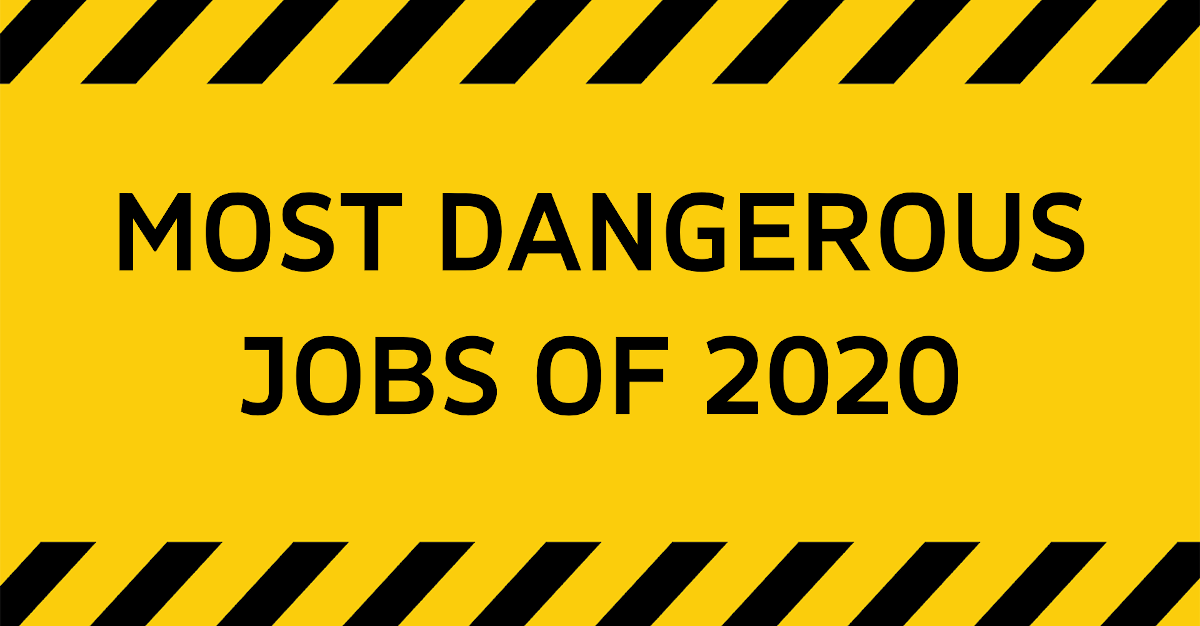Every day people go to work and put their lives at risk, whether they are driving a truck, working construction, or flying a plane. But what jobs are the most dangerous? That can be determined by looking at the fatality rate. The Bureau of Labor Statistics calculates the fatality rate of a job by taking the number of deaths per 100,000 full-time workers. (1) This method ensures that every profession is represented correctly, no matter how large or small the industry. These are the top 10 most dangerous jobs of 2020, according to MoneyTalksNews and EHS Today: (2, 3)
1. LOGGING WORKERS
It may not come as much of a surprise that the occupation with the highest fatality rate is logging workers, with 97.6 fatal work injuries per 100,000 workers, making logging occupations the deadliest jobs of 2020. Most of the injuries stem from contact with a machine like a heavy-duty power tool or being struck by a log or falling tree. Industry experts continue searching for ways to keep logging workers safer, such as instituting safety measures and recommending or requiring safety equipment such as hardhats.
2. FISHERS AND RELATED FISHING WORKERS
Many people who don’t work in the commercial fishing industry might imagine long relaxing days on the beautiful water, occasionally clearing out a full net. However, this vital industry is far from relaxing these days. As the second most dangerous occupations of 2020, commercial fishers have a work fatality rate of 77.4 deaths per 100,000 workers. The cause of the deaths can usually be attributed to drowning, weather conditions, collisions and shipwrecks, falls on slippery decks, large and unexpected waves crashing on decks, or malfunctioning gear.
3. AIRCRAFT PILOTS AND FLIGHT ENGINEERS
While driving is often thought of as more dangerous than flying, when it comes to fatality rates on the job, the pilots rank higher. They can get their passengers to their destination safely, for the large part, but they struggle to keep themselves healthy. Commercial pilots, crew members, and flight engineers often fight the frequent or often ongoing effects of irregular travel, sleep schedules, and continuous jetlag. On average, the occupation has a 58.9 fatal injury rate, mostly caused by plane crashes. Cropduster and helicopter pilots face their own respective risks that put their lives in danger during each shift.
4. ROOFERS
It isn’t much of a surprise that roofing is high on the list of dangerous jobs since these professionals climb ladders and walk around on steep roofs all day. They need to stay alert, watch their balance, and watch out for fellow workers since falls from roofs cause more than one-third of the industry deaths. The fatality rate for this profession is 51.5, with more than 100 fatalities each year. As suspected, most of these are caused by falls. Injuries and illnesses are also common in roofing due to the materials they use and the weather they face.
5. REFUSE AND RECYCLABLE MATERIAL COLLECTORS
Many people may not consider refuse and recyclable collection a dangerous job, but workers put their lives on the line each time they clear residents’ containers. Its fatality rate comes in at 44.3, and most of these are caused by either the worker or the truck getting struck by another vehicle when trying to pass without slowing down.
6. TRUCK DRIVERS, SALES WORKERS, AND OTHER DRIVERS
Every worker’s daily commute is fraught with traffic, frustration, and danger. The risks increase exponentially for workers whose job is to drive all day long. Due to traffic accidents, truck drivers and other driving professionals experience a 26 fatal work injury rate, making these the sixth most dangerous occupations of 2020.
7. FARMERS, RANCHERS, AND AGRICULTURAL MANAGERS
In an industry that is vital to everyone, it is important to keep in mind that farmers, ranchers, and agricultural workers face risks daily. Even with the technological advances in the past few decades, farmers and ranchers still have to work with a lot of heavy equipment and machinery in inclement and otherwise uncooperative weather conditions. They also work with a variety of motorized vehicles, such as tractors and lawnmowers, which are the main culprit in the 24.7 fatality work rate for the profession, making it seventh on the list of the most dangerous trades of 2020.
8. STRUCTURAL IRON AND STEELWORKERS
Working with iron and steel beams and cranes all day is no doubt hazardous. Even though the materials they work with are heavy and massive, most of the 23.6 deaths per 100,000 workers are caused by falling or slipping accidents. Despite the obvious risks in this industry, there is no sign of its appeal wearing off for workers, as it shows an anticipated 11% growth projection from 2018 to 2028, per the Bureau of Labor Statistics. (4)
9. SUPERVISORS OF CONSTRUCTION AND EXTRACTION WORKERS
For some reason, construction and extraction supervisors find themselves in more peril than their workers. The job has a fatality rate of 21 deaths per 100,000 full-time equivalent workers, with falls being responsible for half of the 134 actual fatalities. The other main risk factor for this job is being hit by a falling or swinging object. Additional professionals in this category include electricians, carpenters, construction equipment operators, and building inspectors.
10. GROUNDS MAINTENANCE, LANDSCAPING, AND TREE SERVICE WORKERS
Finishing off the top 10 dangerous jobs of 2020 are landscapers, groundskeepers, tree service workers, and gardeners. It may seem simple enough, but these workers are consistently exposed to the elements, heights, and sharp tools, giving them a fatality rate of 20.2 deaths per 100,00 full-time equivalent workers. In 2018, the industry reported 225 fatal work-related incidents. To put it in perspective, even though this is the last job on this list, that is still five times higher than the average work fatality rate.
After reviewing the most dangerous jobs of 2020, it is clear that employee safety is a serious concern, no matter what industry you are in. At Appspace, we help companies raise safety awareness with safety signage. Because it’s a visual communication tool, it grabs your employees’ attention and takes your safety communication to a new level. To learn more about how we can help you make your workplace safer, contact us today.
Sources
(2) https://www.moneytalksnews.com/slideshows/most-dangerous-jobs/2/
(3) https://www.ehstoday.com/safety/media-gallery/21132346/top-10-most-dangerous-jobs-of-2020/slideshow




